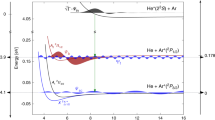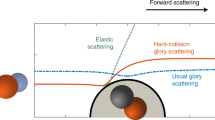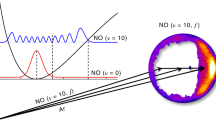Abstract
The hydroxyl radical (OH) is one of the most interesting molecules in molecular dynamics. In particular, inelastic collisions of free radicals such as OH are profoundly important in environments ranging from combustion to astrochemistry. However, measuring the velocities of OH molecules in specific internal quantum states has proven to be very difficult. A method that can provide this important information is velocity-map imaging. Although this technique is very widely applicable in principle, it does require a sensitive and selective laser-ionization scheme. Here we show that, under the right conditions, velocity-map imaging can be applied to the study of the inelastic scattering of OH using crossed-molecular-beam methods. We measure fully quantum-state-specified product angular distributions for OH collisions with helium and argon. The agreement between exact close-coupling quantum scattering calculations on ab initio potential energy surfaces and experimental data is generally very satisfactory, except for scattering in the most forward directions.
This is a preview of subscription content, access via your institution
Access options
Subscribe to this journal
Receive 12 print issues and online access
$259.00 per year
only $21.58 per issue
Buy this article
- Purchase on Springer Link
- Instant access to full article PDF
Prices may be subject to local taxes which are calculated during checkout



Similar content being viewed by others
References
Miller, J. A., Pilling, M. J. & Troe, J. Unravelling combustion mechanisms through a quantitative understanding of elementary reactions. Proc. Combust. Inst. 30, 43–88 (2005).
Heard, D. E. & Pilling, M. J. Measurement of OH and HO2 in the troposphere. Chem. Rev. 103, 5163–5198 (2003).
Ausfelder, F. & McKendrick, K. G. The dynamics of reactions of O(3P) atoms with saturated hydrocarbons and related compounds. Prog. React. Kinet. Mech. 25, 299–370 (2000).
Yang, X. Multiple channel dynamics in the O(1D) reaction with alkanes. Phys. Chem. Chem. Phys. 8, 205–215 (2006).
Engel, V. et al. Photodissociation of water in the first absorption band: a prototype for dissociation on a repulsive potential energy surface. J. Phys. Chem. 96, 3201–3213 (1992).
Andresen, P. Classification of pump mechanisms for astronomical OH masers and a maser model for the H2O photodissociation pump mechanism. Astron. Astrophys. 154, 42–54 (1986).
Kirste, M. et al. Low-energy inelastic collisions of OH radicals with He atoms and D2 molecules. Phys. Rev. A 82, 042717 (2010).
Andresen, P., Häusler, D. & Lülf, H. W. Selective Λ-doublet population of OH in inelastic collisions with H2: a possible pump mechanism for the 2Π1/2 astronomical OH maser. J. Chem. Phys. 81, 571–572 (1984).
Costen, M. L., Marinakis, S. & McKendrick, K. G. Do vectors point the way to understanding energy transfer in molecular collisions? Chem. Soc. Rev. 37, 732–743 (2008).
Costen, M. L. et al. Elastic depolarization of OH(A) by He and Ar: a comparative study. J. Phys. Chem. A 113, 15156–15170 (2009).
Paterson, G. et al. Orientation and alignment depolarization in OH(X2Π)+Ar/He collisions. J. Chem. Phys. 129, 074304 (2008).
Van Beek, M. C., Berden, G., Bethlem, H. L. & ter Meulen, J. J. Molecular reorientation in collisions of OH + Ar. Phys. Rev. Lett. 86, 4001–4004 (2001).
Baba, M., Brouard, M., Rayner, S. P. & Simons, J. P. Elastic scattering dynamics of translationally and rotationally aligned molecular fragments via Doppler-resolved laser spectroscopy. OH(X2Π3/2)+Ar/He. Chem. Phys. Lett. 220, 411–416 (1994).
Eppink, A. T. J. B. & Parker, D. H. Velocity map imaging of ions and electrons using electrostatic lenses: application in photoelectron and photofragment ion imaging of molecular oxygen. Rev. Sci. Instrum. 68, 3477–3484 (1997).
Buijsse, B. et al. Angular distributions for photodissociation of O2 in the Herzberg continuum. J. Chem. Phys. 108, 7229–7243 (1998).
Lin, J. J., Zhou, J. G., Shiu, W. C. & Liu, K. State-specific correlation of coincident product pairs in the F + CD4 reaction. Science 300, 966–969 (2003).
McRaven, C., Alnis, J., Furneaux, B. & Shafer-Ray, N. A 1 + 1 ionization scheme for sensitive detection of the OH radical. J. Phys. Chem. A 107, 7138–7141 (2003).
Greenslade, M. E., Lester, M. I., Radenović, D. Č., van Roij, A. J. A. & Parker, D. H. (2+1) resonance-enhanced ionization spectroscopy of a state-selected beam of OH radicals. J. Chem. Phys. 123, 074309 (2005).
Hama, T. et al. Translational and internal energy distributions of methyl and hydroxyl radicals produced by 157 nm photodissociation of amorphous solid methanol. J. Chem. Phys. 131, 224512 (2009).
Wang, F. Y. et al. UV photodissociation dynamics of nitric acid: the hydroxyl elimination channel. Chin. J. Chem. Phys. 22, 191 (2009).
Huang, C. S., Zhang, C. M. & Yang, X. M. State-selected imaging studies of formic acid photodissociation dynamics. J. Chem. Phys. 132, 154306 (2010).
Lee, H-S., McCoy, A. B., Toczyłowski, R. R. & Cybulski, S. M. Theoretical studies of the and states of the He–OH and Ne–OH complexes. J. Chem. Phys. 113, 5736–5749 (2000).
Paterson, G. et al. Orientation and alignment depolarization in OH(X2Π) + Ar/He collisions. J. Chem. Phys. 129, 074304 (2008); erratum 131, 159901 (2009).
Brown, J. M. & Carrington, A. Rotational Spectroscopy of Diatomic Molecules (Cambridge Univ. Press, 2003).
McBane, G. C. IMSIM program, version 2.0; available at http://faculty.gvsu.edu/mcbaneg/
Dagdigian, P. J. & Alexander, M. H. Tensor cross sections and collisional depolarization of OH(X2Π) in collisions with helium. J. Chem. Phys. 130, 164315 (2009).
Dagdigian, P. J. & Alexander, M. H. Tensor cross sections and the collisional evolution of state multipoles: OH(X2Π)–Ar. J. Chem. Phys. 130, 094303 (2009).
Pavlovic, Z., Tscherbul, T. V., Sadeghpour, H. R., Groenenboom, G. C. & Dalgarno, A. Cold collisions of OH(2Π) molecules with He atoms in external fields. J. Phys. Chem. A 113, 14670–14680 (2009).
Sawyer, B. C., Stuhl, B. K., Wang, D., Yeo, M. & Ye, J. Molecular beam collisions with a magnetically trapped target. Phys. Rev. Lett. 101, 203203 (2008).
Tscherbul, T. V., Pavlovic, Z., Sadeghpour, H. R., Côté, R. & Dalgarno, A. Collisions of trapped molecules with slow beams. Phys. Rev. A 82, 022704 (2010).
Dong, F., Lee, S. H. & Liu, K. Reactive excitation functions for F + p-H2/n-H2/D2 and the vibrational branching for F + HD. J. Chem. Phys. 113, 3633 (2000).
Schreel, K., Schleipen, J., Eppink, A. & ter Meulen, J. J. State-to-state cross-sections for rotational-excitation of OH by collisions with He and Ar. J. Chem. Phys. 99, 8713 (1993).
Yang, C. H. et al. Communication: mapping water collisions for interstellar space conditions. J. Chem. Phys. 133, 131103 (2010).
Marinakis, S., Paterson, G., Kłos, J., Costen, M. L. & McKendrick, K. G. Inelastic scattering of OH(X2Π) with Ar and He: a combined polarization spectroscopy and quantum scattering study. Phys. Chem. Chem. Phys. 9, 4414–4426 (2007).
Alexander, M. H., Manolopoulos, D. E., Werner, H-J. & Follmeg, B. HIBRIDON; available at http://www2.chem.umd.edu/groups/alexander/hibridon/hib43/hibhelp.html
Degli Esposti, A., Berning, A. & Werner, H-J. Quantum scattering studies of the Λ doublet resolved rotational energy transfer of OH(X2Π) in collisions with He and Ar. J. Chem. Phys. 103, 2067–2082 (1995).
Acknowledgements
Research in Nijmegen was supported by the Netherlands NWO-CW project 700.58.029, the Dutch Astrochemistry Network, and the EU-ITN Network ‘ICONIC’ 238671. S. Marinakis was supported by EPSRC (UK) and the British Council–Platform Bèta Techniek Programme in Science. K.G.M. was supported by EPSRC (UK). S. Marinakis thanks S. Cybulski and J. Kłos for providing the HeOH/ArOH PES, J. Kłos for many useful discussions and suggestions, B.J. Howard (Oxford) and F.J. Aoiz (Madrid) for encouraging discussions, and the use of the Oxford Supercomputing Centre in carrying out this work.
Author information
Authors and Affiliations
Contributions
D.H.P., J.J.tM. and K.G.M. supervised the project and designed the experiments. G.S. performed the VMI experiments and collected and analysed the data with assistance from S.M., who performed the quantum calculations with assistance in interpretation from K.G.M. G.S. and D.H.P. wrote the manuscript with significant input from J.J.tM., S.M. and K.G.M.
Corresponding author
Ethics declarations
Competing interests
The authors declare no competing financial interests.
Supplementary information
Supplementary information
Supplementary information (PDF 819 kb)
Rights and permissions
About this article
Cite this article
Sarma, G., Marinakis, S., ter Meulen, J. et al. Inelastic scattering of hydroxyl radicals with helium and argon by velocity-map imaging. Nature Chem 4, 985–989 (2012). https://doi.org/10.1038/nchem.1480
Received:
Accepted:
Published:
Issue Date:
DOI: https://doi.org/10.1038/nchem.1480



